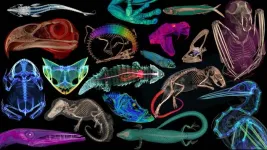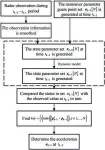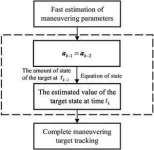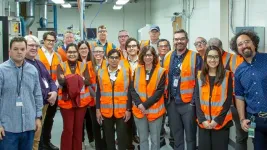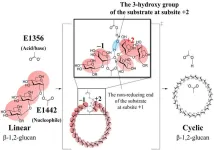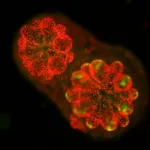(Press-News.org) Read the online version (Available 8:00 a.m. ET, March 6, 2024)
Watch the video (Embargoed. Do not distribute before 8:00 a.m. ET, March 6, 2024)
Natural history museums have entered a new stage of scientific discovery and accessibility with the completion of openVertebrate (oVert), a five-year collaborative project among 18 institutions to create 3D reconstructions of vertebrate specimens and make them freely available online.
Researchers published a summary of the project in the journal BioScience in which they review the specimens that have been scanned to date and offer a glimpse of how the data might be used to ask new questions and spur the development of innovative technology.
“When people first collected these specimens, they had no idea what the future would hold for them,” said Edward Stanley, co-principal investigator of the oVert project and associate scientist at the Florida Museum of Natural History.
Natural history museums got their start in the 16th century as cabinets of curiosity, in which a few wealthy individuals amassed rare and exotic specimens, which they kept mostly to themselves. Since then, museums have become a resource for the public, with exhibits that showcase biodiversity for anyone interested in learning about it.
However, the majority of museum collections remain behind closed doors, accessible only to scientists who must either travel to see them or ask that a small number of specimens be mailed on loan. The research team behind oVert wants to change that.
“If you require someone to get on a plane and travel to you to collaborate, that’s prohibitive in a lot of ways,” said David Blackburn, lead principal investigator of the oVert project and curator of herpetology at the Florida Museum. “Now we have scientists, teachers, students and artists around the world using these data remotely.”
Between 2017 and 2023, oVert project members took CT scans of more than 13,000 specimens, with representative species across the vertebrate tree of life. This includes more than half the genera of all amphibians, reptiles, fishes and mammals. CT scanners use high-energy X-rays to peer past an organism’s exterior and view the dense bone structure beneath. Thus, skeletons make up the majority of oVert reconstructions. A small number of specimens were also stained with a temporary contrast-enhancing solution that allowed researchers to visualize soft tissues, such as skin, muscle and other organs.
The models give an intimate look at internal portions of a specimen that could previously only be observed through destructive dissection and tissue sampling.
“Museums are constantly engaged in a balancing act,” Blackburn said. “You want to protect specimens, but you also want to have people use them. oVert is a way of reducing the wear and tear on samples while also increasing access, and it’s the next logical step in the mission of museum collections.”
oVert was funded with an initial sum of $2.5 million from the National Science Foundation, along with eight additional partnering grants totaling $1.1 million that were used to expand the project’s scope. The goal was to initially scan only specimens preserved in ethyl alcohol, which represent the bulk of fish, reptile and amphibian collections. Specimens that are too large for fluid preservation are also unlikely to fit into a CT scanner, but researchers were reluctant to leave these out.
A partnering grant to the Idaho Museum of Natural History was used to create a digital model of a humpback whale. The entire specimen was too big to scan with sufficient resolution, so researchers painstakingly took apart the skeleton, produced 3D models of each individual bone, then reassembled the physical and digital specimen.
Even moderately sized specimens at times required a little ingenuity, as was the case with a set of iconic tortoises at the California Academy of Sciences.
“They have the largest Galapagos tortoise collection in the world. These are not things you put in boxes and loan,” Blackburn said.
Using funds from another partnering grant, curatorial staff members had to come up with a way to photograph each tortoise in a 360-degree rotation. Photographing their undersides was problematic, as their curved shells made it impossible to keep them upright. After a few trial-and-error runs, they settled on placing the specimens on top of inflatable swimming tubes.
Scientists have already used data from the project to gain astonishing insights into the natural world.
In 2023, Edward Stanley was conducting routine CT scans of spiny mice and was surprised to find their tails were covered with an internal coat of bony plates, called osteoderms. Before this discovery, armadillos were considered to be the only living mammals with these structures.
“All kinds of things jump out at you when you’re when you’re scanning,” Stanley said. “I study osteoderms, and through kismet or fate, I happened to be the one scanning those particular specimens on that particular day and noticed something strange about their tails on the X-ray. That happens all the time. We’ve found all sorts of strange, unexpected things.”
CT scans from oVert were also used to determine what killed a rim rock crown snake, considered to be the rarest snake species in North America. Another study showed that a group of frogs called pumpkin toadlets had become so small that the fluid-filled canals in their ears that confer balance no longer functioned properly, causing them to crash-land when jumping. A massive study of more than 500 oVert specimens revealed that frogs have lost and regained teeth more than 20 times throughout their evolutionary history. And yet another study concluded that Spinosaurus, a massive dinosaur that was larger than Tyrannosaurus rex and thought to be aquatic, would have actually have been a poor swimmer, and thus likely stayed on land.
And the list goes on, full of insights and ideas that would have been impossible or impractical before the project’s outset. “Now that we’ve been working on this for so long, we have a broad scaffold that allows us to take a broader view of evolutionary questions,” Stanley said.
The value of oVert extends beyond scientific inquiry as well. Artists have used the 3D models to create realistic animal replicas, photographs of oVert specimens have been displayed as museum exhibits, and specimens have been incorporated into virtual reality headsets that give users the chance to interact with and manipulate them.
oVert models have are also used by educators. From the outset of the project, Blackburn and his colleagues wanted to place a strong emphasis on K-12 outreach. They organized workshops where teachers could learn how to use the data in their classrooms.
“It’s been a game-changer for my evolution unit,” said Jennifer Broo, a high school teacher in Cincinnati. “I teach juniors and seniors, and I absolutely love them, but they can be a tough audience. They know when things are fake, which makes them less engaged. Using the oVert models, you can teach concepts at an appropriate level while also maintaining the authenticity of the science. My class has gotten so much better because I have had the opportunities to work with and expose my students to real data.”
There’s virtually no end to the number of things oVert could be used for. The biggest challenge will be creating tools that are sophisticated enough to analyze the data. Never before have this many 3D natural history specimens been publicly available and instantly accessible, and it will take further developments in machine learning and supercomputing to use them to their full potential.
“Generating the data is just the start,” said Jaimi Gray, a postdoctoral associate at the Florida Museum who’s working on NoCTURN (Non-Clinical Tomography Users Research Network), a project developed toward the end of oVert to make the best use of CT scans possible. “The aim of oVert was always to facilitate the exploration of vertebrate diversity. We’re going to keep exploring, but the goal of NoCTURN is to give people the tools to use the data, whether it’s for research, education or industry.”
END
Scientists-CT scanned thousands of natural history specimens, which you can access for free
2024-03-06
ELSE PRESS RELEASES FROM THIS DATE:
INFUSE workshop gives private and public fusion partners a chance to network and share experiences
2024-03-06
More than 120 people gathered for the 2024 Innovation Network for Fusion Energy (INFUSE) Workshop at the U.S. Department of Energy’s (DOE) Princeton Plasma Physics Laboratory (PPPL) from Feb. 27-28.
The event, which was sponsored by the DOE’s Office of Fusion Energy Sciences (FES), is a part of the INFUSE awards program that funds laboratories or universities so they can partner with private sector companies working on the science and technology ...
Uncovering the cyclization mechanism of cyclic β-1,2-glucan synthase
2024-03-06
The polysaccharide β-1,2-glucan consists of repeating units of glucose linked together by β-1,2-glycosidic bonds. Cyclic β-1,2-glucans (CβGs) occur in different bacterial species and have a role in bacterial infections and symbiotic relationships. CβG biosynthesis is catalyzed by cyclic β-1,2-glucan synthase (CGS), an enzyme that catalyzes the cyclization (closed ring formation) of linear β-1,2-glucan (LβG).
Since the method for large-scale enzymatic synthesis of linear β-1,2-glucan has already been established, combining it with this enzyme is technically feasible for efficient ...
Marine algae implants could boost crop yields
2024-03-06
Scientists have discovered the gene that enables marine algae to make a unique type of chlorophyll. They successfully implanted this gene in a land plant, paving the way for better crop yields on less land.
Finding the gene solves a long-standing mystery amongst scientists about the molecular pathways that allow the algae to manufacture this chlorophyll and survive.
“Marine algae produce half of all the oxygen we breathe, even more than plants on land. And they feed huge food webs, fish that get eaten by mammals and humans,” said UC Riverside ...
Model estimates who benefits most from frequent COVID-19 boosters
2024-03-06
Patients kept asking a question that Nathan Lo, MD, PhD, infectious disease specialist, had a hard time answering: How often should I get my booster shot for COVID-19?
“It’s a question that we have all asked. My patients have asked; friends and family members have asked,” Lo said. “We point to the national vaccine recommendations, although increasingly this question has become challenging to answer. I didn’t quite have the estimates on hand that I might hope to share with patients.”
To build that evidence, Lo and his team at Stanford ...
XPANCEO and Nobel laureate unveil the new properties discovery in graphene-like materials, transforming healthcare, AI and AR
2024-03-06
XPANCEO, a deep tech company developing the first smart contact lenses with XR vision, health monitoring, and content surfing features, in collaboration with the Nobel laureate Konstantin S. Novoselov (National University of Singapore, University of Manchester) and professor Luis Martin-Moreno (Instituto de Nanociencia y Materiales de Aragon), has announced in Nature Communications a groundbreaking discovery of new properties of rhenium diselenide and rhenium disulfide, enabling novel mode of light-matter interaction with huge potential for integrated photonics, healthcare, and AR. Rhenium disulfide ...
More than half of American Indian youth may have abnormal or high cholesterol
2024-03-06
More than 70% of American Indian young adults aged 20-39 and 50% of American Indian teens have cholesterol levels or elevated fat in the blood that put them at risk for cardiovascular disease, suggests a study supported by the National Institutes of Health. In some cases, these levels — specifically high low-density lipoprotein (LDL) cholesterol, often thought of as “bad cholesterol,” — were linked to plaque buildup and cardiovascular events, such as heart attack and stroke.
The findings, ...
How does wearing makeup affect skin during exercise?
2024-03-06
New research published in the Journal of Cosmetic Dermatology reveals the effects of wearing cosmetic foundation during aerobic exercise on the skin and its pores.
The study included 43 healthy college students (20 males and 23 females). Foundation cream was applied to participants on half of the face in two different areas (forehead and upper cheek). The other half of the face served as control.
Moisture increased after exercise in both the non-makeup and makeup zones; however, there was a greater increase in moisture in the makeup zones. This may be a result of makeup preventing ...
Can artificial intelligence–based systems spot hard-to-detect space debris?
2024-03-06
An increasing number of space objects, debris, and satellites in Low Earth Orbit poses a significant threat of collisions during space operations. The situation is currently monitored by radar and radio-telescopes that track space objects, but much of space debris is composed of very small metallic objects that are difficult to detect. In a study published in IET Radar, Sonar & Navigation, investigators demonstrate the benefits of using deep learning—a form of artificial intelligence—for small space object detection by ...
How does a diabetes drug lessen symptoms of depression?
2024-03-06
Research in animals has shown that the diabetes drug dulaglutide, which is a glucagon-like peptide-1 (GLP-1) receptor agonist may reduce symptoms of depression. A new study published in Brain and Behavior reveals the mechanisms that are likely involved.
By conducting a range of tests in mice treated with and without dulaglutide, investigators confirmed the effects of dulaglutide on depressive-like behaviors, and they identified 64 different metabolites and four major pathways in the brain associated with these effects.
Markers of depression and the antidepressant effects of dulaglutide were linked to lipid metabolism, amino acid metabolism, energy metabolism, ...
How do artificial intelligence programs fare in dermatology applications for people with diverse skin tones?
2024-03-06
Artificial intelligence (AI) programs have recently acquired widespread popularity in dermatology for assessing, diagnosing, and treating skin conditions. As reported in the International Journal of Dermatology, investigators recently analyzed all published studies from the last 10 years to evaluate current AI programs in use for dermatologic purposes, uncovering significant shortcomings when applied to skin of color (SOC).
The researchers identified various challenges when this technology is applied to SOC, ...
